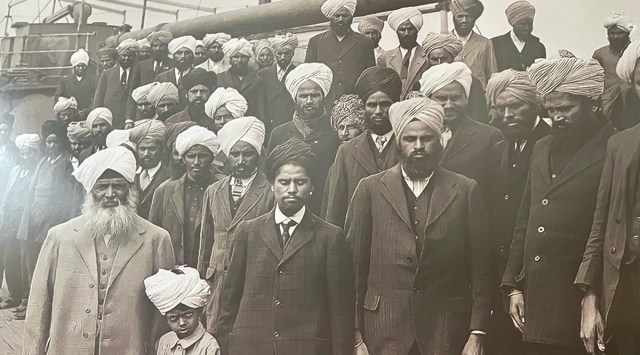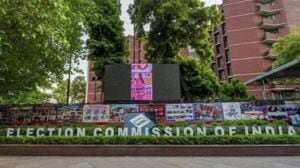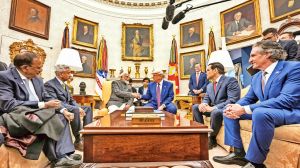A calendar tracks the history of Sikhs in Canada
Curated by Karen Dosanjh, a Canadian-born historian, and shared generously by Patrick Herbert, consul general of Canada in Chandigarh, the calendar brings to life the struggles and successes of the first wave of migrants from Punjab to Canada in the early 1900s.
 Passengers who sailed into Vancouver on the steamship Komagatamaru.
Passengers who sailed into Vancouver on the steamship Komagatamaru. If you want a quick primer on the history of Sikhs in Canada, look no further than this calendar by SikhLens. Curated by Karen Dosanjh, a Canadian-born historian and author of Untold Stories: The South Asian Pioneer Experience in BC, and shared generously by Patrick Herbert, consul general of Canada in Chandigarh, the calendar brings to life the struggles and successes of the first wave of migrants from Punjab to Canada in the early 1900s.
Karen, who has a formidable reputation as a PR and marketing professional, has painstakingly chronicled the journey of the Sikh pioneers as they set about establishing their families in their new homeland despite racial barriers.
 Kesur Singh, a Risaldar Major in the British India Army (25th Cavalry, Frontier Force), is considered the first Sikh settler to arrive in Canada in 1897.
Kesur Singh, a Risaldar Major in the British India Army (25th Cavalry, Frontier Force), is considered the first Sikh settler to arrive in Canada in 1897.
January opens with an impressive picture of Kesur Singh, a Risaldar Major in the British India Army (25th Cavalry, Frontier Force), who is considered the first Sikh settler to arrive in Canada in 1897. He was amongst the first group of Sikh soldiers who arrived in Vancouver as part of the Hong Kong Regiment, which included Chinese and Japanese soldiers en route to celebrate Queen Victoria’s Diamond Jubilee. Back in India, they told people about the spectacular place called Canada and the bountiful opportunities that lay there inspiring many to follow their path.
February charts the journey of a small group of Sikh villagers, a mix of discharged British soldiers and young labourers, who came to Canada in search of work primarily in the lumber, agricultural and railway industries. As word spread to Punjab about the potential for job opportunities, the pace of immigration steadily increased, and by the end of 1908, their number had swelled to over 2000. The Canadian media reported the immigration influx from India as a “Hindoo Invasion”, reflecting the racist climate of the times. But the settlers stayed firm, and on January 19, 1908, they took out the first “nagar kirtan”.
 The first Sikhs to arrive in Canada, the land of limitless opportunities, were usually discharged British soldiers or men from villages in search of work.
The first Sikhs to arrive in Canada, the land of limitless opportunities, were usually discharged British soldiers or men from villages in search of work.
The first Sikh temple in North America was built at 1866 West 2nd Avenue, Vancouver, BC. The calendar recounts how it became the central place of worship for the local Sikhs, and provided free meals to everyone who visited regardless of their religious affiliation. It was also a place where immigrants came together to socialise.
There were few Sikh women migrants to Canada in the initial years. On August 28, 1912, Hardial Singh Atwal was the first child born to parents of Indian origin at the Sikh temple in Vancouver. His father Balwant Singh (the first Sikh temple priest), immigrated to Canada in 1906 and his mother, Kartar Kaur, who was detained by the Canadian immigration for some time, was allowed entry into the country in what the government called “an act of grace” as she was expecting a baby and was traveling with two other young children. At that time, Sikh men would go back to Punjab to marry and would return to Canada without their wives. The birth of Hardial Singh, narrates the calendar, was a monumental occasion for Sikhs in Canada as it marked the beginning of family formation.
 Hardial Singh Atwal (the baby) was the first child born to parents of Indian origin at the Sikh temple in Vancouver.
Hardial Singh Atwal (the baby) was the first child born to parents of Indian origin at the Sikh temple in Vancouver.
But it was only after the imperial War Conference in 1919 that the Indian government successfully secured an agreement which finally permitted Indian women, and children under 18, to immigrate to Canada.
Turn to May for an interesting account of how the Japanese steamship, the Komagata Maru, sailed into Vancouver’s Burrard Inlet with 376 passengers on May 23, 1914. Punjabi entrepreneur Gurdit Singh Sandhu (from Sarhali) chartered the ship with the vision of helping his people and of challenging Canada’s exclusionary immigration laws that blocked immigration from India to Canada. Upon arrival, the that the ship violated continuous journey laws since it had not sailed directly from India.
Only 22 passengers, who were returning immigrants, were allowed to re-enter the country. The other passengers fought a legal battle in the BC Court of Appeal but lost. The Komagata Maru was ordered to return to Asia on July 23, 1914. Tragically, upon return to India, the ship was fired upon and 20 people were killed and 200 were imprisoned. On May 23, 2016, Prime Minister Justin Trudeau, issue a formal apology for the discriminatory treatment meted out to the ship passengers.
 Dr. Durai Pal Pandia, an Oxford educated lawyer and former secretary to Mahatma Gandhi, in helping the Sikhs fight for their right to vote.
Dr. Durai Pal Pandia, an Oxford educated lawyer and former secretary to Mahatma Gandhi, in helping the Sikhs fight for their right to vote.
August recounts the tryst of Sikhs with the Canadian army. Private Buckam Singh is believed to be the first Canadian Sikh solider to serve in combat on the fields of Flanders in 1916, as a member of the 20th Canadian Infantry Battalion. Singh, who came to BC as a teenage farmer in 1907, was wounded in the battle and later died from complications related to his injuries. He was treated by Dr. John McCrae who went on to write the iconic wartime poem In Flanders Fields. It is believed that at least ten Sikh men enlisted in the Canadian Army during WW.
The calendar also celebrates the contribution of great humanists like Dr. Durai Pal Pandia, an Oxford educated lawyer and former secretary to Mahatma Gandhi, in helping the Sikhs fight for their right to vote. Dr. Pandia, who was from the south of the Vindhyas, worked persistently with immigration officials in Vancouver, Victoria and Ottawa and was instrumental in persuading the federal government to grant amnesty to over 350 people. A kindhearted man, Dr. Pandia was known to take on clients who could not afford to pay for their legal services. In 1946, Dr. Pandia and business leaders, Kartar Singh, Kapoor Singh Siddoo and Mayo Singh, attended an annual meeting of BC mayors to seek the right to vote in municipal elections.
Dr. Pandia was given five minutes to speak on the closing day. Referring to Kapoor Singh and Mayo Singh, both successful BC mill owners, he stated, “These two men have hundreds of employees working for them. Their workers are allowed to vote, but these two mill owners cannot vote because they are East Indians.” Dr. Pandia‘s message struck a chord and the mayors passed a resolution to grant Sikh immigrants the right to vote in municipal elections.
But it was only in 1947 that Sikhs were finally granted the right to vote and to become Canadian citizens. Mahinder Singh Beadall made history by becoming the first Sikh to cast a vote in Canada. The Canadian Government also allowed Sikh Canadians to sponsor relatives, including mothers, and fathers over the age of 65. By 1962, the government removed almost all racial and national restrictions from its Immigration Act.
As per the calendar, today there are approximately 500,000 Sikhs in Canada, constituting 1.4% of the country’s population. In 2017, Canada became the first country in the world to adopt a formal legislation recognizing April as Sikh Heritage Month.












